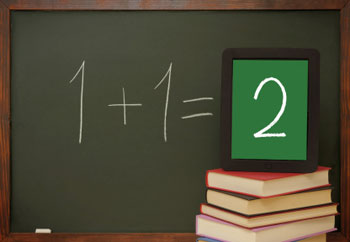Math Games for Junior High Students: Fun Games to Play at Home
Are you trying to get your junior high student actively engaged in his or her math studies? Consider using the fun games below to help your child improve his or her skills and motivation.

What Will My Junior High Student Be Learning?
At the sixth grade level, children learn to fluently add, subtract, multiply and divide multi-digit numbers. These whole numbers may or may not contain decimals. Sixth graders also determine the greatest common factor (GCF) and least common multiple (LCM) of a set of whole numbers.
In seventh grade, students solve addition, subtraction, multiplication and division problems involving rational numbers, which includes negative numbers. Finally, eigth graders are introduced to irrational numbers, such as pi.
Find the GCF and LCM
Before beginning this activity, write a variety of numbers on small pieces of paper and place them in a bowl. To provide ample practice, include both 1-digit and 2-digit numbers. Have your child select two pieces of paper from the bowl and calculate the greatest common factor (GCF) of the two numbers. Then, have your child determine the least common multiple (LCM) of the same two numbers.
For example, if the selected numbers were three and 40, then the GCF would be one because that's the only factor that the two integers have in common. The LCM is 120, which can be calculated by multiplying 40 x 3 = 120. Continue drawing numbers from the bowl and calculating the GCF and LCM until your child feels comfortable with these skills. If your child is more advanced, feel free to have him or her draw three numbers out of the bowl at a time.
Red and Black Addition
For this addition activity, you will only need a deck of cards (remove the face cards before playing). Divide the deck in half and give each player a stack of cards. Red cards will represent negative numbers and black cards will represent positive numbers. For each round, players will turn over the top two cards from their stack and add them together.
For example, if a player turns over a black seven card and a red four card then he or she would add: 7 + (-4) = 3. At the end of each round, the player with the largest sum will take possession of all the cards played. The player with the most cards at the end of the game wins!
Other Articles You May Be Interested In
-
MIND Games Lead to Math Gains

Imagine a math teaching tool so effective that it need only be employed twice per week for less than an hour to result in huge proficiency gains. Impossible, you say? Not so...and MIND Research Institute has the virtual penguin to prove it.
-
5 Free and Fun Math Games for Kids

Looking for a way to get your child engaged with math? There are many free, fun math games online that explore basic concepts such as addition, subtraction, multiplication and division, as well as more advanced games that offer practice with decimals and fractions. Read on to discover five of our favorite educational - and fun! -...
We Found 7 Tutors You Might Be Interested In
Huntington Learning

- What Huntington Learning offers:
- Online and in-center tutoring
- One on one tutoring
- Every Huntington tutor is certified and trained extensively on the most effective teaching methods
K12

- What K12 offers:
- Online tutoring
- Has a strong and effective partnership with public and private schools
- AdvancED-accredited corporation meeting the highest standards of educational management
Kaplan Kids

- What Kaplan Kids offers:
- Online tutoring
- Customized learning plans
- Real-Time Progress Reports track your child's progress
Kumon

- What Kumon offers:
- In-center tutoring
- Individualized programs for your child
- Helps your child develop the skills and study habits needed to improve their academic performance
Sylvan Learning

- What Sylvan Learning offers:
- Online and in-center tutoring
- Sylvan tutors are certified teachers who provide personalized instruction
- Regular assessment and progress reports
Tutor Doctor

- What Tutor Doctor offers:
- In-Home tutoring
- One on one attention by the tutor
- Develops personlized programs by working with your child's existing homework
TutorVista

- What TutorVista offers:
- Online tutoring
- Student works one-on-one with a professional tutor
- Using the virtual whiteboard workspace to share problems, solutions and explanations